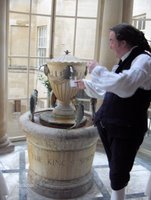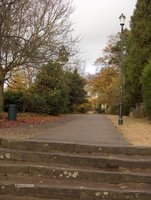“Ah,” as in “Bath”

Aquae Sulis, a.k.a. Bath Spa, is a bit of a haul from Cambridge. Because of problems with the London Underground connection between Paddington and King’s Cross, it took almost four hours each way. Still, I had about six hours to explore the city itself. It rained through late morning, but then turned into a beautiful, mild afternoon.
I would have been happy to travel all that way just to see the Roman baths.
 Yes, this site has been all froo-frooed up by the Victorians. And the museum’s audio-tour seems a bit Disney-Worldy, but the omnipresent school kids seemed to love it, and, miraculously, not one of them ended up in the water though I myself slipped awfully close to having a much more exciting blog entry. The guided tour was excellent; I think the docent was a grad. student in archaeology. She explained especially well the uniqueness of this site as both a temple of Minerva and a Roman public bath. The boar may represent the 20th Legion who constructed the bath. . .Sooie,-orum, -is, -os, -is. There was a good deal of geology too. . .I kind of zoned. But two stories really captured my attention. First, was the medieval survival of the site–I guess it’s no surprise I rallied for this. The main pool that the Romans used as a public bath was not the sacred spring of Minerva. The temple pool itself was sacrosanct. . .and besides its water temp. was a rump-reddening 115 F.; the bathing pool run-off cooled to about 95 F. But the public pool’s ceiling collapsed probably soon after the Saxons came, and the drains clogged, and the main site was buried in mud. But the medieval monks of Bath continued to use Minerva’s higher bathtub for the aqua therapy of invalids. . .ahhh; this story reminded me of the Colosseum being used as a hospital. My second favorite story was about a drunk student pushing the (quite modern) statue of Julius Caesar into the main bath. . .somewhat less inspiring.
Yes, this site has been all froo-frooed up by the Victorians. And the museum’s audio-tour seems a bit Disney-Worldy, but the omnipresent school kids seemed to love it, and, miraculously, not one of them ended up in the water though I myself slipped awfully close to having a much more exciting blog entry. The guided tour was excellent; I think the docent was a grad. student in archaeology. She explained especially well the uniqueness of this site as both a temple of Minerva and a Roman public bath. The boar may represent the 20th Legion who constructed the bath. . .Sooie,-orum, -is, -os, -is. There was a good deal of geology too. . .I kind of zoned. But two stories really captured my attention. First, was the medieval survival of the site–I guess it’s no surprise I rallied for this. The main pool that the Romans used as a public bath was not the sacred spring of Minerva. The temple pool itself was sacrosanct. . .and besides its water temp. was a rump-reddening 115 F.; the bathing pool run-off cooled to about 95 F. But the public pool’s ceiling collapsed probably soon after the Saxons came, and the drains clogged, and the main site was buried in mud. But the medieval monks of Bath continued to use Minerva’s higher bathtub for the aqua therapy of invalids. . .ahhh; this story reminded me of the Colosseum being used as a hospital. My second favorite story was about a drunk student pushing the (quite modern) statue of Julius Caesar into the main bath. . .somewhat less inspiring.Next to and above the now excavated bath site is the “Pump Room”
 where I tasted some of the water with its 43 minerals and 8 unspecified trace elements; it was not so bad as advertized. Starting from the Pump Room, I had to dedicate the rest of the afternoon to a Jane Austen pilgrimage. I walked the Gravel Path (which is now paved, harrumph),
where I tasted some of the water with its 43 minerals and 8 unspecified trace elements; it was not so bad as advertized. Starting from the Pump Room, I had to dedicate the rest of the afternoon to a Jane Austen pilgrimage. I walked the Gravel Path (which is now paved, harrumph),
and visited the Jane Austen Centre on Gay Street, but several houses down from No. 25 which is now a dentist’s office.
The abbey church is quite bright and beautiful,
 totally fake medieval, but quite inspiring still. Its floors were lined with art students today.
totally fake medieval, but quite inspiring still. Its floors were lined with art students today. On the way back to the train station, I stopped at the Pulteney Bridge which the brochures call the “Ponte Vecchio of Bath.”
 Well, it’s much smaller, no gold shops, and it’s hardly so “vecchio,” but it is charming, as is the whole eighteenth-century neat and orderly, polite and polished look of this entire city which Jane both loved and loathed.
Well, it’s much smaller, no gold shops, and it’s hardly so “vecchio,” but it is charming, as is the whole eighteenth-century neat and orderly, polite and polished look of this entire city which Jane both loved and loathed.My only gripe: not a single mention of Alison.

0 Comments:
Post a Comment
<< Home